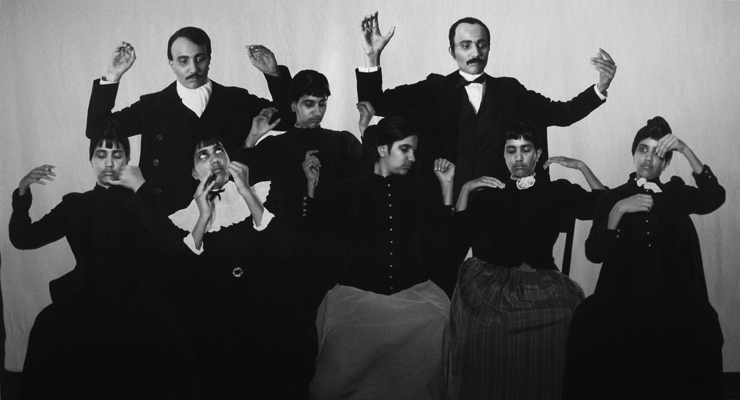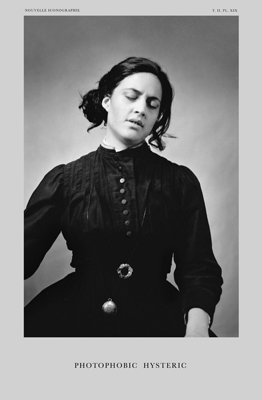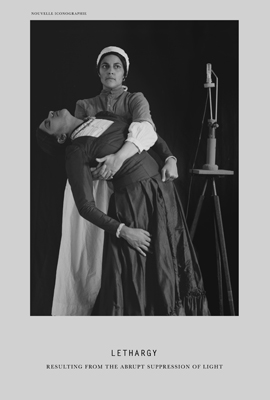|
|
||||||||||||||||||||||
|
|
||||||||||||||||||||||
| | | Artists | | | EXHIBITIONS | | | COLLATERAL PROGRAMMING | | | ART FAIRS | | | ABOUT | | | PUBLICATIONS | | | VIEWING ROOM | | | NEWS | | THE GUILD ART JOURNAL | | BLOG | | | CONTACT | |||
|
|

Group Catalepsy or The Ship
of Fools, 2008
|
As an artist confronting and exploring photography as the chosen medium of expression, Tejal seem to have bridged the inherent immediacy of the photograph with the qualitatively different contiguity and immediacy offered by performance art. In her recent project Hysteria: Iconography from the Salpetrier Series comprising of black & white photographs, she employs de-familiarization as a strategy and tool to unravel attributes that are without doubt liminal to photography as a medium. Derived from the book 'Invention of Hysteria': by French philosopher Georges Didi-Huberman, this suite of works explore Tejals's prime concern, of the body as a gendered and sexualized entity and the marginalization of the transgendered in the historical narrative of social reality. The term “de-familiarization” was first coined in 1917 by Viktor Shklovsky , Russian formalist and literary critic as a device or strategy to impose the poetic upon the practical by interrupting the linear unhindered understanding of the commonplace. Essentially, at the core of de-familiarization is the idea that poetic language and imagery need to be fundamentally different from the language we use on an everyday basis and has to be framed in such a way as to prevent the habitual association of images and words . In simple terms the technique or requirement is to make objects ‘unfamiliar’ in order to increase the length of perceptual engagement from the viewer or reader, because the process of perception is an aesthetic end in itself and must be prolonged. As against her past work which has more or less relied on the direct and instantaneous dissemination of sense and meaning, Hysteria: Iconography from the Salpetrier Series as a project is a departure in its skillful use of de-familiarization in order to withhold immediate gratification and extend the length and duration of perceptual engagement wherein there is a gradual and steady unraveling of nuances. The images take off from the original illustrations in Georges Didi-Huberman's book to explore the subtexts and the history embedded within the archival photographic illustrations and explores the nexus between the patient or model, doctor, and the assertion of science as authority through staged enactment of events and episodes. Tejal's photographic enactments or performances of these same situations are brought about mostly by herself playing multiple roles, but in a few frames we also have Paris based dancer and choreographer Marion Perrin who collaborated in the project. The multiple selves that populate some of the frames in the suit seem to have been played out upon the virtual stage through the agency of an image processor rather than the traditional device of multiple exposures, in-camera or otherwise. It is this virtual staging and arranging which makes these works edge themselves out of the framework of photography and stake claim to a patently liminal space somewhere between the realm of performance and digital image manipulation. The strength of performance art resides in its immediacy, which makes it antithetical to the technologies of reproduction and representation where dynamics of the technology articulates not immediacy but fossilization. In fact there is well defined skepticism regarding the role of the photograph in the documentation of performance art. Allan Kaprow, well known for orchestrating performance events in the 1960s, felt that it brought an unwanted dimension of the arrested spectacle to a fluid evanescent event. So it is quite interesting to see technically incompatible genres colliding and resolving in a kind of synthetic cross border merger in this suit of photographs. In many ways the works in this suit also suggest the departure from modernist purist positions or vestiges of them which still linger on in the field of black & white photography. Black and white photography carries with it an aura of the factual and the unadulterated, which the purists have always claimed and defended as mark of real photography. But from the position of the artist who aims to push the envelope and to re-signify existing and overused habitual conceptual and aesthetic positions, the purist's position would equate to the extension of the practical and the commonplace. Thus with the intentional displacement of time and space, Tejal defines a non-ordinary space through her black & white photography — a space that depends not on facts but on the viewer to make it come alive, very much in the line of performance art. Baiju Parthan’s art practice revolves around information technology and its impact on perception and meaning generation. The artist lives and works in Mumbai.
|
|||
|
Photophobic Hysteric, 2008 |
Lethargy-Resulting from the Abrupt Suppression of Light, 2008 |
||
|
© Text : The Guild. All rights reserved. |
|||

